June 2019 has brought with it some of the most prominent justice campaigns social media has ever seen.
media update’s Nicole van Wyk takes a stroll down June Lane to look back on all of the social media memories made at The Twitter Café, Instagram Photobooth and The Facebook Gallery.
Twitter removes location-tagging
The news: Twitter location-tagging will no longer be available on the app. On the one hand, this is a victory for data privacy and safety; however, on the other hand, it only makes fact checking that much more difficult to navigate.
Location data is an important element of any researcher’s work, and location tagging made it easier to accumulate the information needed to investigate something as and when a story breaks.
Having location-tagging available made a journalist’s job of verifying sources during groundbreaking events all the more simple by allowing them to search for a particular area via
Twitter location-tags. It is still possible to tag precise locations, so all hope is not lost for journos.
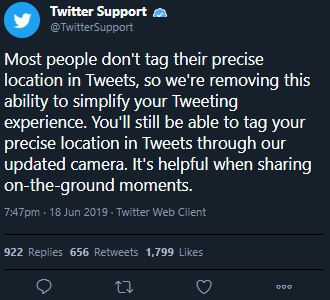 Why it’s making headlines:
Why it’s making headlines: Location-tagging is an instrumental tool in news conveyance. It connects the global digital village and allows data to be shared in this way. Journalists and researchers use this function to connect online posts to real-time and real-world events so that important information about socio-political climates, smaller neighbourhoods and communities can be documented.
The removal of this feature is security positive. It is indicative of Twitter’s commitment to protecting its users from harm, like leaving a digital footprint and having a predator follow a user’s whereabouts via location-tagging.
Facebook and Instagram pull out all the stops for Pride Month
The news: June is #PrideMonth, and Facebook and Instagram both released new app features to show their support to the #LGBTQIA+ community. These features set to empower queer expression and to allow allies hop on board and show their support for the commmunity.
According to the Instagram Info Center, “No matter how you celebrate Pride, you can do it colorfully across Instagram. Together with GLAAD, we’ve identified prominent and popular hashtags — such as #lgbtq, #BornPerfect, #EqualityMatters, #AccelerateAcceptance or #pride2019 — that the LGBTQ+ community uses to share and connect with each other.”
“When you use these hashtags in [your] Feed this month, they will be displayed in a rainbow gradient. New this Pride, when you use these hashtags in Stories, your story ring will turn rainbow while the photo or video is live for 24 hours.”
 Instagram Info Center
Instagram Info Center
The power of social media campaigning is spreading beyond the parameters of Instagram’s online platform — ‘the Gram’, in collaboration with @lgbt_history, have introduced #UntoldPride. This movement aims to highlight lesser-known LGBTQIA+ historical figures, spaces, places and pioneers.
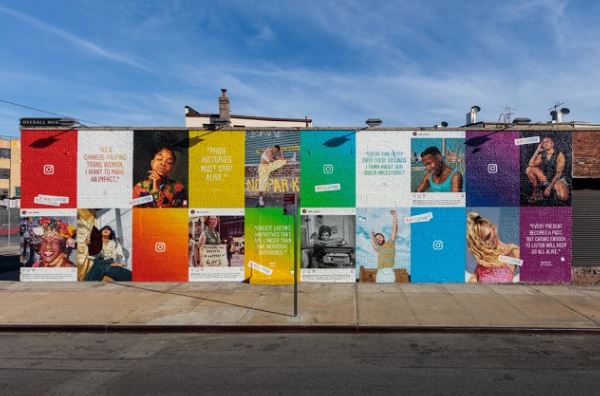 Instagram Info Center
Instagram Info Center
In light of Pride Month, Instagram has also added an update to their profile features — more gender listing options for users to choose from. According to Instagram, "We’re updating the gender selection … to be more inclusive and reflective of how people self-identify today."
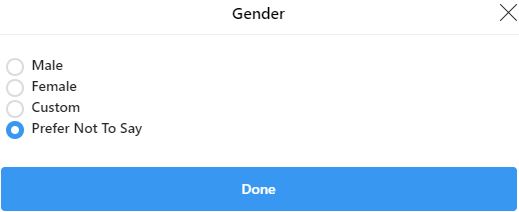
Meanwhile, on Facebook all sorts of colourful features are being offered in support of Pride Month. Everything from rainbow-themed post backgrounds to filters you can apply to photos will be available to show your support for the LGBTQIA+ community.
Facebook users can also use limited edition Pride reactions available during Pride Month to express your pride for a post.
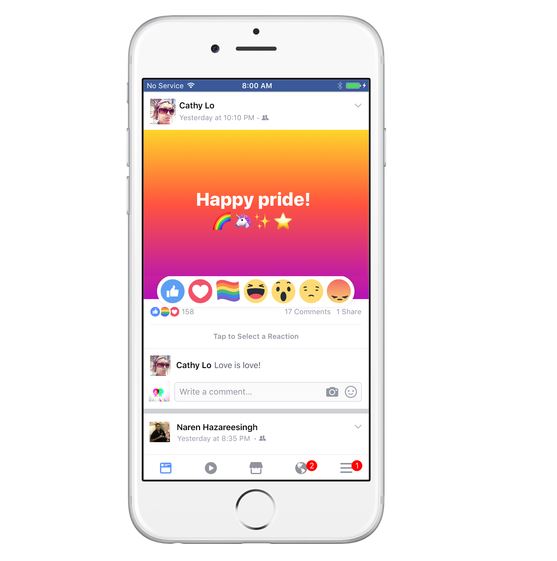 The Facebook Newsroom
The Facebook Newsroom
Add a rainbow to your personalised photo, apply Pride themed masks and frames to photographs. You also have the option of swiping to the left of the News Feed, click on the magic wand and use the mask, frame and rainbow filter features.
 The Facebook Newsroom
The Facebook Newsroom
Even Facebook Messenger is in on the Pride celebration. During Pride Month, you will be able to send Pride themed stickers and effects using the Messenger Camera.
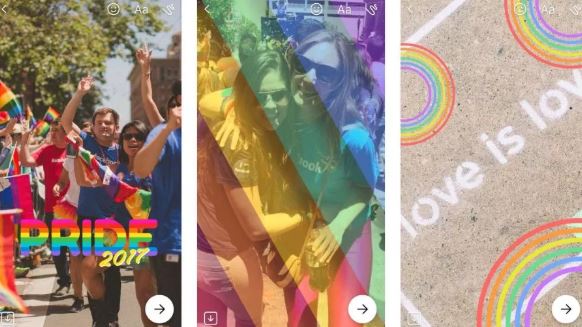 The Facebook Newsroom
The Facebook Newsroom
Why it’s making headlines:
All of the features rolled out by Facebook and Instagram during Pride Month have proven to be a part of long-term plans for both apps to continue supporting the LGBTQIA+ community. This is a socially progressive stance by two of the most prominent social media networks and the platforms are creating safe spaces for this community to share their stories and fully express themselves without the fear of not gaining any support.
According to The Facebook Newsroom, the platform’s “commitment and support of the LGBTQ community has been unwavering. From [the] support of marriage equality and bullying prevention, to the many product experiences that [they’ve] brought to life, [they] are proud of [their] attention to the LGBTQ experience on Facebook, often thanks to the many LGBTQ people and allies who work [there]”.
Blue for Sudan
The news: Earlier this year, Sudanese President Omar al-Bashir was forced to step down after civilians expressed their dissatisfaction towards him and his regime. He served as president for 30 years and was found guilty of leading a genocide in Dafur that led to brutal mass killlings.
The Sudanese uprising was consequently sparked by this, coupled with the fact that civilians were experiencing food shortages and other price increases. The Sudanese revolution is occurring because Sudanese people are disgruntled by the fact that the military will be taking over despite the people’s call for a civilian led government.
During this time a young man called
Mohamed Mattar was killed by the Rapid Support Forces (RSF) on Monday, 3 June during a peaceful sit-in demonstration held outside the military headquarters in Khartoum. The Sudanese people were demanding the military hand over power to the Sudanese people.
Why it’s making headlines:
Blue was believed to be Mohamed Mattar’s favourite colour, and so, Twitter users change their profile pictures to this colour to show their support and to raise awareness about the situation in Sudan.

The #BlueForSudan hashtag started spreading like wildfire as more and more people learned about the context of the social media campaign. This tribute to Mattar became a symbol of solidarity for the Sudanese revolution
Social media users follow trends, so a timeline of blue profile pictures naturally sparked curiosity. That, in turn, created awareness and opened the floor for questions and conversations about why blue was the chosen colour and who it is linked to.
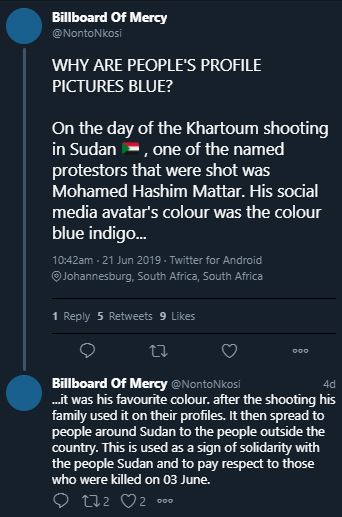 The increased awareness has been useful for news coverage in the region, especially during a time where the Sudanese government decided to shut down the Internet, making on-the-ground coverage difficult.
The increased awareness has been useful for news coverage in the region, especially during a time where the Sudanese government decided to shut down the Internet, making on-the-ground coverage difficult.
Do you use your personal social media platforms to promote the social justice causes you support? Let us know in the comments section below.
Want to stay up to date with the latest news? Subscribe to our newsletter.